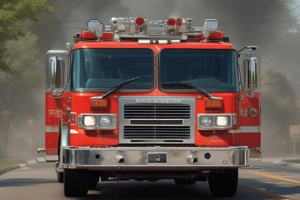Podcast
Questions and Answers
What percentage of communication is delivered through body language?
What percentage of communication is delivered through body language?
- Half
- A minority
- Almost none
- A majority (correct)
What is an important aspect of verbal communication?
What is an important aspect of verbal communication?
- Speaking clearly and using understandable words (correct)
- Talking quickly to save time
- Using complex medical terminology
- Raising your voice to be heard
Why is it important to position yourself at or below the patient's eye level?
Why is it important to position yourself at or below the patient's eye level?
- To see the patient's face more clearly
- To hear the patient more clearly
- To assert dominance
- To demonstrate caring and compassion (correct)
What is an important aspect of written communication?
What is an important aspect of written communication?
What is the purpose of the transfer of care?
What is the purpose of the transfer of care?
What is the primary purpose of patient care reports?
What is the primary purpose of patient care reports?
What is the primary function of a repeater in a radio system?
What is the primary function of a repeater in a radio system?
What is included in the minimum data set for patient care reports?
What is included in the minimum data set for patient care reports?
What is the purpose of a base station radio in a dispatch center?
What is the purpose of a base station radio in a dispatch center?
What is an advantage of using laptop computers for patient care reports?
What is an advantage of using laptop computers for patient care reports?
Flashcards are hidden until you start studying
Study Notes
Effective Communication
- Communication is the activity of conveying information
- Individuals to communicate with: patients, partner, other EMS personnel, fire personnel, and law enforcement personnel
Types of Communication
- Verbal: words and sounds that make up language we speak
- Nonverbal: body language, eye contact, and gestures
- Written: use of letters and words to express language we speak
- Visual: signs, symbols, and designs
Strategies for Effective Communication
- Speak clearly and use understandable words and terminology
- Keep an open mind and resist being defensive
- Be an active listener
- Be assertive, especially when safety is at stake
Strategies for Successful Interviewing
- Introduce yourself and your level of training
- Obtain patient's name early and use it frequently during the interview
- Position yourself at or below patient's eye level to demonstrate caring and compassion
- Ask one question at a time and listen carefully to the patient's responses
- Restate patient's answers for clarification when necessary
Transfer of Care
- Physical and verbal "handing off" of care from one healthcare provider to another
- Continuum of care ensures consistent and appropriate care
- Information to transfer: patient's name and age, chief complaint, brief account of current condition, past pertinent medical history, vital signs, pertinent findings from physical exam, overview of care provided, and patient's response to care
Radio Communications
- Radio system: transmitters, receivers, repeaters, and antennae
- Dispatch centers use base station radios that transmit over a wide area
- EMS personnel carry pagers and handheld radios
Patient Care Reports
- Documentation is a permanent record of provided care
- Reports may be handwritten or electronic
- Recognized by different titles: run reports, patient care reports, prehospital care reports
Reasons for Accurate and Complete Documentation
- Continuity of care
- Education
- Administration
- Quality assurance
- Legal purposes
Minimum Data Set
- Time incident was reported to 911
- Time of dispatch
- Time of arrival at patient's location
- Time patient was transported from incident location
- Time patient arrived at destination
- Time patient care was transferred to more advanced providers
- Patient's chief complaint, vital signs, demographics (age, gender, race, weight)
Methods of Documentation
- Paper forms: PCR forms filled out by hand
- Computer-scan forms: PCR forms completed by hand in a fill-in-the-bubble format
- PDAs or handheld computers: specialized software for entering PCR information
- Laptop computers: software for completing PCR and printing or sending wirelessly to hospital or central database
- Data-enabled cellular devices: advance documentation methods
Studying That Suits You
Use AI to generate personalized quizzes and flashcards to suit your learning preferences.




